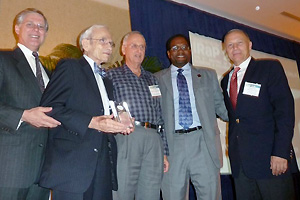News Story
Silverman Receives Lifetime Achievement Award

Professor Emeritus Joseph Silverman (second from left) is presented with IRaP's Lifetime Achievement Award by Clark School dean Darryll Pines (second from right) and MSE professor Mohamad Al-Sheikhly (far right).
Professor Emeritus Joseph Silverman (Department of Materials Science and Engineering [MSE]) received a Lifetime Achievement Award for his fundamental and applied work in radiation physics and chemistry at the 9th International Symposium on Ionizing Radiation and Polymers (IRaP 2010), held October 25-29 at the University of Maryland. Clark School dean Darryll Pines and Professor Mohamad Al-Sheikhly (MSE) presented Silverman with the award at the conference's gala.
IRaP's Lifetime Achievement Award honors individuals who have dedicated their careers to the advancement of the international radiation and polymer community, and who have distinguished themselves as preeminent leaders in the fields of radiation chemistry and polymer engineering.
The IRaP award is only one of the many honors Silverman has received, including appointments to Fellow of the American Nuclear Society and the American Physical Society, and a Guggenheim Fellowship in 1966. He also served as the director of the National Institute of Standards and Technology (NIST) from 1976-1983.
Silverman received his doctorate in physical chemistry from Columbia University in 1951. After eight years in industry and a year as an associate professor of chemistry at what is now Stony Brook University, he was recruited by the late Professor Dick Duffey to join the faculty of the Department of Chemical Engineering, launch the school's nuclear engineering program, and help start up its original nuclear reactor. He designed and installed the university's first radiation facilities and supporting laboratories, and also developed the first academic curriculum for the science and engineering of chemical processes induced by ionizing radiation. From 1970-1971, Silverman was a key member of the team that installed the nuclear reactor and related facilities the are still in use today. He is almost single-handedly responsible for the design of the current radiation vaults and their contents.
"I designed just about every bolt you see in the vaults for our electron linear accelerators and the cobalt-60 source," he says. "My gifted successor and friend, Professor Al-Sheikhly, is responsible for acquiring one of the LINACs and latest cobalt-60 source, [which has] four times [more curies than] my last one."
Although no longer teaching or advising, Silverman maintains an active research program in collaboration with Al-Sheikhly and his students. They recently published two fundamental works on the nature of free radicals in Macromolecules, and are developing the first intramolecularly-linked nanogels for use in drug delivery systems. They have also recently begun collaborating with Professor Michael Coplan (Electron and Optical Physics Division, NIST) on the design of ultrasensitive thermal neutron detectors. Silverman is proud to have left an indelible mark on A. James Clark School of Engineering.
"Most professors' work is replaced over time, and the facilities they've built do not survive their retirement," he says. "I've been very fortunate. My research, the teaching I have done and the laboratories I have built continue on."
Published November 9, 2010









